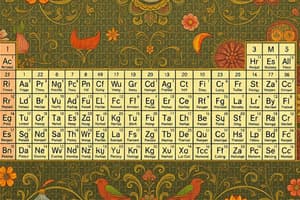Podcast
Questions and Answers
Which group of elements is characterized by stability and non-reactivity?
Which group of elements is characterized by stability and non-reactivity?
- Alkali earth metals
- Transition metals
- Post-transition metals
- Noble gases (correct)
Where are the p-block elements located in the periodic table?
Where are the p-block elements located in the periodic table?
- Groups 13 to 18 (correct)
- Groups 3 to 5
- Groups 1 to 12
- Groups 6 to 10
What is a key characteristic of transition metals?
What is a key characteristic of transition metals?
- Stability and non-reactivity
- Ability to form stable ions with variable oxidation states (correct)
- Non-reactivity
- Location in groups 13 to 18 of the periodic table
Which section of the periodic table includes the s-block elements?
Which section of the periodic table includes the s-block elements?
Why is understanding the periodic classification of elements crucial?
Why is understanding the periodic classification of elements crucial?
Flashcards are hidden until you start studying
Study Notes
Periodic Classification of Elements
The periodic classification of elements is a system that organizes all chemical elements based on their properties and atomic structure. This classification is essential for understanding the behavior of elements and predicting their characteristics. One of the most important aspects of the periodic classification system is the identification of patterns and trends in the properties of elements.
Dobereiener's Triads
Dobereiener's triads refer to the repetition of elements that form triads within groups in the periodic table. These triads are formed by two groups of elements, followed by a group of transition metals. The first two groups consist of s-block elements and p-block elements, while the third group consists of transition metals. This pattern can be observed throughout the periodic table, with the triads featuring elements that share similar properties and behaviors.
S-Block Elements
The s-block elements are located at the left side of the periodic table's first group. They are a set of alkali metals and alkaline earth metals, with hydrogen being the only non-metal in the group. These elements are characterized by their reactivity, as they lose electrons to form positive ions (cations) and form salts when combined with other elements. Some examples of s-block elements include hydrogen, lithium, sodium, magnesium, calcium, strontium, and barium.
P-Block Elements
The p-block elements are a set of elements that are located in groups 13 to 18 and the noble gases. They are characterized by their stability and non-reactivity. The p-block elements include the alkali earth metals, the transition metals, the post-transition metals, and the inner transition metals. Some examples of p-block elements include aluminum, silicon, phosphorus, sulfur, chlorine, argon, krypton, and xenon.
Transition Metals
The transition metals are a set of elements located between the s-block and p-block elements. They are characterized by their metallic properties and their ability to form stable ions with variable oxidation states. The transition metals are further divided into three groups: the early transition metals, the middle transition metals, and the late transition metals. Some examples of transition metals include chromium, manganese, iron, cobalt, nickel, copper, zinc, gallium, germanium, tin, lead, zirconium, hafnium, ruthenium, rhodium, palladium, silver, cadmium, indium, and tin.
Identifying Patterns in the Periodic Table
The periodic classification of elements allows us to identify patterns and trends in the properties of elements. These patterns are based on the arrangement of elements in the periodic table, which is organized based on their atomic structure and properties. The periodic table is divided into several sections, including the s-block elements, p-block elements, transition metals, and inner transition metals.
Understanding Elemental Properties
Understanding the periodic classification of elements is crucial for understanding the properties and behaviors of individual elements. By grouping elements based on their atomic structure and properties, we can predict how elements will react and interact with other elements. This knowledge is essential for various fields, including chemistry, physics, and materials science.
In conclusion, the periodic classification of elements is a valuable tool for understanding the properties and behaviors of elements. By identifying patterns and trends in the properties of elements, we can better predict and explain the behavior of individual elements and their interactions with other elements. The repetition of elements in Dobereiener's triads further highlights the importance of this classification system in the realm of chemistry and materials science.
Studying That Suits You
Use AI to generate personalized quizzes and flashcards to suit your learning preferences.




